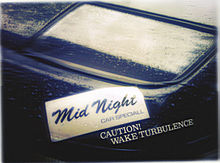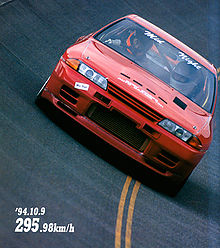- Mid Night Club
-
This article is about the Japanese street racing gang. For the series of video games, see Midnight Club.
The Mid Night Club (ミッド ナイト クラブ Middo Naito Kurabu) was a Japanese street racing gang that hosted illegal top speed themed races on the Bayshore Route (known natively as the Wangan) of the Shuto Expressway between Tokyo to Yokohama. The gang became one of the most notorious and highly respected clubs of its type, which led to it being featured in over 200 editorial features in most of the leading Japanese auto magazines and even in foreign magazines such as the Danish Autoviz, the British Max Power and the American Turbo magazine. One of the earliest non-Japanese media referrals was in the first episode of Jeremy Clarkson's Motorworld in January 1995, when the presenter Jeremy Clarkson, driving his Skyline GT-R around Japan, stated that his car "is more likely to be seen in the Mid Night Club". The show then featured roughly 30 seconds of amateur footage revealing the typical nature of the club. The combination of its dangerously high racing speed, and aggressive racing style gave street racing in Japan a worldwide notoriety. The club was regarded as one of the longest running street racing gangs.
To join the club, which was formed in 1985, was not as easy as the other clubs as it was governed by a series of rules and was far better organised. Additionally, unlike in other groups, the hashiriya (street racer) car was to be capable of going over 250 km/h (160 mph), as a racing speed of over 300 km/h (190 mph) was common. As new members are regarded as apprentices for one year, they were required to attend all the meetings.[1] Only 10% of these drivers would qualify for full membership and they would have to leave if they posed a danger to other motorists and to other members.[1] Members would bear the trademark small rectangle Mid Night Car Speciall sticker on their bumpers, a larger sticker on the sun visor area, and sometimes a Mid Night Racing Team sticker on the side skirt. The high standard of the drivers made it difficult for the police to catch them, as most police cars of the era were limited to 180KM/H, a legal requirement set forth by the 1977 Japanese Automotive Gentlemans Agreement.[1]
On average, there were 30 members in the club, and they met in a designated meeting spot at "midnight", as the name implied; races would take place on the Bayshore Wangan route sometimes leading itself to extended portions of the "Shuto Expressway" for more complicated and intricate top speed runs. The standing/winner of the race would be one of many factors, such as "the ability to no longer see the driver in front" or "To pass a certain Highway Stop first". Although very secretive in fashion, a member was once heard saying " "Drifting" and "Autocross" is for the weak. We only do Maximum Velocity. "
Customary among most racers was to watch out for members of other teams displaying Mid Night Club parophinalia. If a member of another team, or an independent racer was spotted owning a car displaying "Mid Night" stickers/logos that were not part of the actual teams roster, they could face harassment, and in some cases, vandalism inflicted onto their cars. There were many reports of non-member cars wearing the logos being defaced/damaged to a state of disrepair.
In order to organize a meet up, a Mid Night Team "Leader" would place an ad in a "Tokyo" local newspaper, under the "Classifieds" section. Usually it would read of something entirely different then any sort of racing meeting, in order to not draw attention from any unwanted law enforcement. The subject of the ad would have been discussed at the previous meet up, so that the team members could look up the ad and specifically meet up at the exact location in order to begin racing, at the exact time. An example of the Ad would read something like this.
For Sale: Small handbags at discount prices. For more information, I am available for meetup at "Daikoku Parking Area" on Thursday, between 11PM and 2AM. Thank you.
The members would then meet up at the preconceived meeting spot, and begin racing.
As full-fledged members' cars were capable of performing over 320 km/h (200 mph), the cars were usually boasting over 400–600 bhp and one member was rumored to be spending over $2 million on rebuilding and modifications of his Porsche 911. The drivers' professions were never revealed, as by club policy members were not allowed to ask how other members got the money for modifications.[1] Only Max Power, in 1995, revealed the professions of two drivers: one, a RX-7 FD3S owner, was a property developer; the other, who drove a Skyline GT-R R32, ran his family car sales business. Many affluent and well known Japanese "tuning" shop founders are rumoured to be original members however.
The Mid Night Club was disbanded in 1999 when Bōsōzoku gang members were waiting to "play" with the club as they were racing down the expressway, culminating in an accident in which six bikers and two innocent motorists ended up hospitalized. One of the motorists, as well as one of the Bosozoku members were killed. As was the club policy (To not endanger or injure any other motorist, no matter a racer, nor an innocent bystander), such a happening would cause the club to be disbanded immediately and forever.[1] Since then there have been numerous imitators, but with tighter traffic laws making things difficult, most of such groups have since been disbanded.
Despite being no longer in existence, many automotive medias still cite the gang as an inspiration to more irresponsible street racing gangs, such as the June 2008 issue of Max Power, when it ran an article about a street racer gang in London, who claim to race in town centers rather than in expressways. However, the Mid Night Club is highly regarded for being a club which put pedestrian safety first, before their own. Many automotive enthusiasts regard the club as having quite a high sense of moral and honor due to its immediate disbandment post-disaster.
The clubs members seclude themselves in secrecy to this day, many refusing to talk/mention the club under any circumstances.
References
Categories:- Auto racing organizations
- Automobile associations
- 1985 establishments
- Gangs in Asia
Wikimedia Foundation. 2010.


